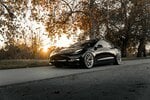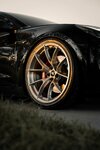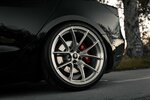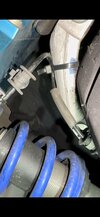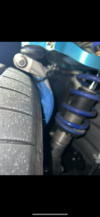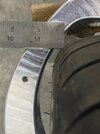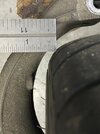I've just trawled through this thread start to finish for the umpteenth time and added a bunch of different confirmed(ish) fitments into a disorganised notepad document. I was in a bit of a scattered state of mind trying to put different brake, wheel, spacer and subjective fit outcomes so please dispute my maths if something looks wrong. Any figures noted below are for non-Performance brake spacing (i.e. factory cast rotors or aftermarket rotors with aluminium hats) so adjust by ~4mm to apply to M3P factory rotors. All offsets are effective offset including spacers if used. Below are some key figures for your dissection, confirmation and/or disagreement:
For inboard fitment (i.e. from the wheel-to-hub mounting plane to the nominal inboard extent of the wheel):
The furthest confirmed inboard fitment for 19" is the
@MountainPass MegaMesh 19"x10.5" ET+33: 166.5mm mount to inner. MPP have a vertical inner lip so a tapered lip at 19" would have a spare millimetre or two.
User
@The Other Dan posts
here showing 18"x11" ET+27*: 166.7mm mount to inner. This corroborates the above; 18" has less clearance to the upright, but this wheel has a tapered inner lip and some mild shaving of the upright resulting in acceptable clerance. (*ET+40 minus 13mm effective spacing: 17mm spacer but stock M3P brake rotors)
Coincidentally in Australia we can't make the track more than 25mm wider than the widest factory option. Allowing for rounding and variability in aluminium rotor hat thickness, my offset limit for an 11" wide wheel is ET+27. The universe is whispering to me.
For outboard fitment (i.e. from the wheel-to-hub mounting plane to a variable and somewhat subjective clearance to the guards):
Note: Outboard fitment is affected heavily by tyre size. I'm going to refer to the outboard extent of the wheel, not the tyre, because we can't even count on two different 295s to be the same width. Thanks for your Goodyear epiphany @MasterC17. I'm only looking at use cases with adjustable FUCAs, I consider it unwise to run this wide with factory camber.
Looking at the fitment from The Other Dan again we get 112.7mm from mount to outer. His post states it clears with approximately three degrees of negative camber, which I consider to be very reasonable for this width.
Next wildest is from
@gearchruncher in
this post showing an 18"x10.5" ET+25, giving 108.5mm from mount to outer, with confirmed clerance on 295/30R18 Hoosiers with 2.3 degrees negative camber. I consider this to corroborate The Other Dan's fitment in general terms.
Notes:
- 18"x11" ET+27 is the widest confirmed fit inboard and outboard
- 18"x10.5" wide is a sensible option if you want to avoid irreversible mods (i.e. upright shaving or hand-pulling the guards).
- 18"x11" with a wide 305 or any 315+ will cause you to have clearance issues both inboard and outboard
- 19"x11" can avoid the need to shave the upright but does not change the tyre clearance limitation at all
- 20"x11" looks badass but same limitation and restricted tyre choice/pricing
- We've found the limit of what the factory panels support without rolling or a wide-body kit



